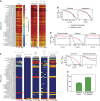Engineering microbial biofuel tolerance and export using efflux pumps
- PMID: 21556065
- PMCID: PMC3130554
- DOI: 10.1038/msb.2011.21
Engineering microbial biofuel tolerance and export using efflux pumps
Abstract
Many compounds being considered as candidates for advanced biofuels are toxic to microorganisms. This introduces an undesirable trade-off when engineering metabolic pathways for biofuel production because the engineered microbes must balance production against survival. Cellular export systems, such as efflux pumps, provide a direct mechanism for reducing biofuel toxicity. To identify novel biofuel pumps, we used bioinformatics to generate a list of all efflux pumps from sequenced bacterial genomes and prioritized a subset of targets for cloning. The resulting library of 43 pumps was heterologously expressed in Escherichia coli, where we tested it against seven representative biofuels. By using a competitive growth assay, we efficiently distinguished pumps that improved survival. For two of the fuels (n-butanol and isopentanol), none of the pumps improved tolerance. For all other fuels, we identified pumps that restored growth in the presence of biofuel. We then tested a beneficial pump directly in a production strain and demonstrated that it improved biofuel yields. Our findings introduce new tools for engineering production strains and utilize the increasingly large database of sequenced genomes.
Conflict of interest statement
JDK has a financial interest in Amyris and LS9.
Figures



Similar articles
-
Trade-Offs in Improving Biofuel Tolerance Using Combinations of Efflux Pumps.ACS Synth Biol. 2015 Oct 16;4(10):1056-63. doi: 10.1021/sb500307w. Epub 2014 Dec 12. ACS Synth Biol. 2015. PMID: 25496359
-
Stress Introduction Rate Alters the Benefit of AcrAB-TolC Efflux Pumps.J Bacteriol. 2017 Dec 5;200(1):e00525-17. doi: 10.1128/JB.00525-17. Print 2018 Jan 1. J Bacteriol. 2017. PMID: 29038251 Free PMC article.
-
Improving microbial biogasoline production in Escherichia coli using tolerance engineering.mBio. 2014 Nov 4;5(6):e01932. doi: 10.1128/mBio.01932-14. mBio. 2014. PMID: 25370492 Free PMC article.
-
Efflux systems in bacteria and their metabolic engineering applications.Appl Microbiol Biotechnol. 2015 Nov;99(22):9381-93. doi: 10.1007/s00253-015-6963-9. Epub 2015 Sep 12. Appl Microbiol Biotechnol. 2015. PMID: 26363557 Free PMC article. Review.
-
Role of efflux in enhancing butanol tolerance of bacteria.J Biotechnol. 2020 Aug 20;320:17-27. doi: 10.1016/j.jbiotec.2020.06.008. Epub 2020 Jun 15. J Biotechnol. 2020. PMID: 32553531 Review.
Cited by
-
Synthetic feedback loop model for increasing microbial biofuel production using a biosensor.Front Microbiol. 2012 Oct 26;3:360. doi: 10.3389/fmicb.2012.00360. eCollection 2012. Front Microbiol. 2012. PMID: 23112794 Free PMC article.
-
Identification of a transporter Slr0982 involved in ethanol tolerance in cyanobacterium Synechocystis sp. PCC 6803.Front Microbiol. 2015 May 18;6:487. doi: 10.3389/fmicb.2015.00487. eCollection 2015. Front Microbiol. 2015. PMID: 26052317 Free PMC article.
-
An ancient Chinese wisdom for metabolic engineering: Yin-Yang.Microb Cell Fact. 2015 Mar 20;14:39. doi: 10.1186/s12934-015-0219-3. Microb Cell Fact. 2015. PMID: 25889067 Free PMC article.
-
Butanol production in S. cerevisiae via a synthetic ABE pathway is enhanced by specific metabolic engineering and butanol resistance.Biotechnol Biofuels. 2015 Jul 8;8:97. doi: 10.1186/s13068-015-0281-4. eCollection 2015. Biotechnol Biofuels. 2015. PMID: 26175798 Free PMC article.
-
Dual-barcoded shotgun expression library sequencing for high-throughput characterization of functional traits in bacteria.Nat Commun. 2019 Jan 18;10(1):308. doi: 10.1038/s41467-018-08177-8. Nat Commun. 2019. PMID: 30659179 Free PMC article.
References
-
- Alper H, Moxley J, Nevoigt E, Fink GR, Stephanopoulos G (2006) Engineering yeast transcription machinery for improved ethanol tolerance and production. Science 314: 1565–1568 - PubMed
-
- Atsumi S, Hanai T, Liao JC (2008) Non-fermentative pathways for synthesis of branched-chain higher alcohols as biofuels. Nature 451: 86–89 - PubMed
-
- Burk MJ (2010) Sustainable production of industrial chemicals from sugars. Int Sugar J 112: 30–35
Publication types
MeSH terms
Substances
LinkOut - more resources
Full Text Sources
Other Literature Sources
Research Materials

